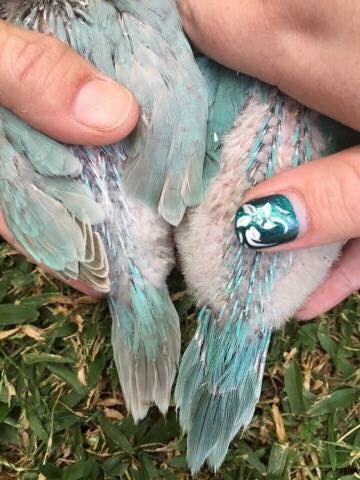Recessive Genes
Recessive genes require one copy of the gene to be passed down from each parent to the offspring so the offspring has two copies. A bird with only one copy is “split” to that mutation, and will pass down that gene to 50% of his or her offspring but will not appear to have the gene. A bird with two copies of the recessive genes shows the color and is called “visual” for that gene. Recessive genes are inherited the same way regardless of the sex of the bird.
Recessive genes include but are not limited to
Blue (“white face” in cockatiels)
Recessive Pied
Cleartail in Indian Ringnecks
Sex-Linked Genes
Sex linked genes are inherited differently than recessive genes.
Male birds require two copies of a sex-linked gene to be “visual,” that is, to show the mutation in their coloring. The male bird must receive one copy of the gene from each of his parents. A male bird who receives only one copy of the gene will be “split” to the gene, that is they will carry the gene but not show it, and will pass it on to 50% of their offspring. A visual male will pass on the gene to 100% of his offspring. Male birds pass on one copy of their sex-linked genes to both their male and female offspring.
Female birds require only one copy of a sex-linked gene to visually show the mutation in their coloring. Because they require only one copy to be visual, female birds cannot be “split” to a sex-linked mutation. Female birds pass their sex-linked genes to ONLY their male offspring.
Because of the unique way sex-linked genes are inherited they provide a convenient way to sex offspring in some cases. If the mother bird does not carry the gene then no visual males can be produced. This means any visual offspring produced by a pair where the hen does not carry the gene is a female, and has received the gene from the father. If neither parent is visual and you get visual offspring then you know the offspring are female, that they received the gene from their father, and thus you know the father is split to that sex-linked gene.
Sex-Linked Genes include but are not limited to
Lutino
Opaline (called “pearl” in Cockatiels and “yellow-sided in Green Cheeked Conures)
Cinnamon
Incomplete Dominant Genes
Incomplete dominant genes are genes which can express themselves with only one copy of the gene present, but which present themselves differently when two copies of the gene are present. These birds can be described as “single factor” (SF) or “double factor” (DF) depending on whether they carry one copy or two. A SF bird will pass the gene down to 50% of his or her offspring, and a DF bird will pass the gene down to 100% of his or her offspring. If only one parent carries the gene the offspring can only be single factor. If both parents carry the gene then it can be passed by both parents and can create double factor offspring.
Incomplete Dominant Genes include but are not limited to
Violet
Dark Factor (often called by other names in various species. For example SF Dark may be called “cobalt” in a blue series bird. DF Dark may be called “Olive” in a green series bird and “Mauve” in a blue series bird.
Spangle in Budgies
Dominant Genes
A domiant gene is one which expresses itself fully whether one or two genes are present in the bird. If they have the gene, they show the gene. The “Normal” or “wildtype” coloration of a species is dominant.
GENE INHERITANCE EXPLANATION


Leave a Reply